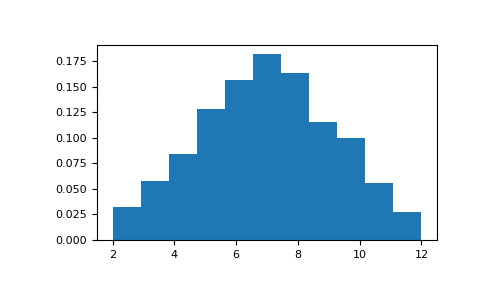numpy.random.RandomState.random_integers#
方法
- random.RandomState.random_integers(low, high=None, size=None)#
类型为
numpy.int_的随机整数,范围在 low 和 high 之间(包括两者)。从闭区间 [low, high] 的“离散均匀”分布中返回类型为
numpy.int_的随机整数。如果 high 为 None(默认值),则结果来自 [1, low]。numpy.int_类型映射到 C 的 long 整型,其精度取决于平台。此函数已被弃用。请使用 randint 代替。
自版本 1.11.0 起已弃用。
- 参数:
- lowint
从分布中抽取的最低(有符号)整数(除非
high=None,在这种情况下,此参数是最高的此类整数)。- highint, optional
如果提供,则为从分布中抽取的最大(有符号)整数(有关
high=None时行为的说明,请参见上文)。- sizeint 或 int 的元组,可选
输出形状。如果给定的形状例如是
(m, n, k),则将抽取m * n * k个样本。默认为 None,在这种情况下返回单个值。
- 返回:
另请参阅
randint类似于
random_integers,但仅用于半开区间 [low, high),并且如果省略 high,则最低值为 0。
备注
要对 a 和 b 之间的 N 个等距浮点数进行采样,请使用
a + (b - a) * (np.random.random_integers(N) - 1) / (N - 1.)
示例
>>> np.random.random_integers(5) 4 # random >>> type(np.random.random_integers(5)) <class 'numpy.int64'> >>> np.random.random_integers(5, size=(3,2)) array([[5, 4], # random [3, 3], [4, 5]])
从 0 和 2.5 之间(包括两者)的五个等距数字集中选择五个随机数字(即,从集合 \({0, 5/8, 10/8, 15/8, 20/8}\) 中选择)。
>>> 2.5 * (np.random.random_integers(5, size=(5,)) - 1) / 4. array([ 0.625, 1.25 , 0.625, 0.625, 2.5 ]) # random
掷两个六面骰子 1000 次并计算结果的总和。
>>> d1 = np.random.random_integers(1, 6, 1000) >>> d2 = np.random.random_integers(1, 6, 1000) >>> dsums = d1 + d2
将结果显示为直方图。
>>> import matplotlib.pyplot as plt >>> count, bins, ignored = plt.hist(dsums, 11, density=True) >>> plt.show()
